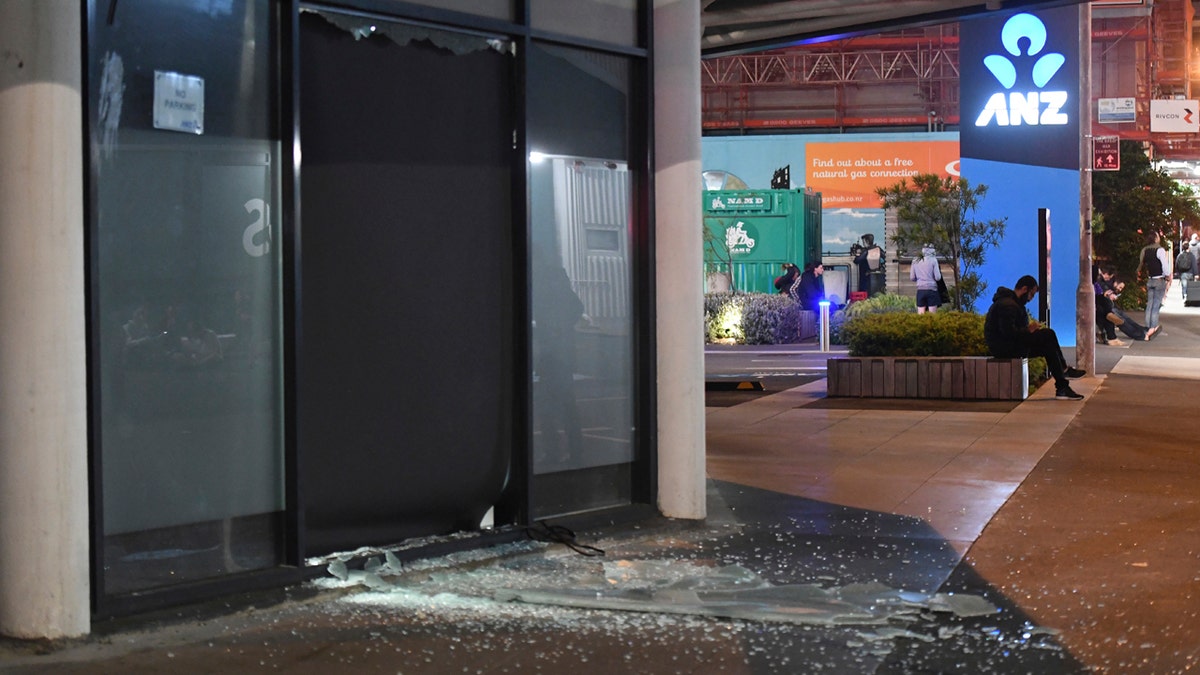
A broken window is seen in Tory Street after people were evacuated from the building in Wellington, New Zealand after an earthquake shook the capital. (Ross Setford/SNPA via AP)
At least two people were killed after a powerful earthquake struck New Zealand near the city of Christchurch early Sunday morning, Prime Minister John Key said during a news conference.
The magnitude-7.8 earthquake sent strong jolts felt over 120 miles away in the capital, Wellington, and prompted emergency services to warn people along the coast to move to higher ground to avoid tsunami waves.
The quake struck just after midnight in a mostly rural area close to the city of Christchurch, according to the USGS.

(USGS)
The full extent of the damage was still being assessed on Sunday and Key didn't discount the possibility the death toll could rise.
The quake appeared to be more strongly felt in Wellington, the capital, more than 120 miles to the north. Residents said the shaking went on for about three minutes, and was followed by a number of strong aftershocks.
Authorities in Wellington were urging people who work in the center of the city to stay home on Monday. City officials said that some large buildings were showing signs of structural stress, and that the quake would likely have caused a mess in some buildings. The city's suburban rail network was shut while crews checked tracks, bridges and tunnels.
The quake temporarily knocked out New Zealand's emergency call number, 111, police reported. Near the epicenter, it opened up snaking fissures in roads and triggered landslides. In Wellington, it collapsed a ferry loading ramp, broke windows and caused items to fall from shelves. It also forced hundreds of tourists onto the streets as hotels were evacuated.
New Zealand's Ministry of Civil Defence and Emergency Management reported that a tsunami wave struck at about 1:50 a.m. and warned residents living in low-lying areas anywhere along the country's east coast to move to higher ground.
Information from the Pacific Tsunami Warning Center indicated that the tsunami waves could be highest around the South Island town of Kaikoura, at about 5 feet. The Hawaii-based center said it did not expect the quake to generate a destructive Pacific-wide tsunami.
Within New Zealand, there was confusion about the tsunami threat.
The ministry initially sent out a message on Twitter saying there was no tsunami threat. But then it sent out another message — "situation has changed - tsunami is possible" — before reporting that a tsunami had hit. The ministry then said people on the coast near the epicenter could expect waves of between 10 and 16 feet.
The tsunami threat is for the east coast of all New Zealand (including Christchurch, Wellington and the Chatham islands) #eqnz pic.twitter.com/z85tsZ0e27
— MCDEM (@NZcivildefence) November 13, 2016
Christchurch resident Hannah Gin told the Associated Press she had just sat down in her living room to watch a replay of this weekend's All Blacks versus Italy rugby match when her house started shaking. Upstairs, her mother let out a scream.
Gin, a 24-year-old lifelong Christchurch resident, is accustomed to quakes, so she told the AP she sat calmly and waited, figuring the rumbling would stop in a few seconds. Instead, the shaking just went on and on — for at least three minutes, according to the clock on her phone, she said by phone.
The quake was far less violent than the one that struck her city in 2011, Gin said, adding that there was no jarring up and down or side to side, just a long, rolling sensation. But it went on for much longer than the typical quakes that strike the area, she said. She was less concerned about running for cover than she was about vomiting from the motion sickness, she said with a chuckle.
"I could hear the sliding door sliding back and forth and we've got washing hanging up and I could see the washing moving," Gin said. "It just kept going and going."
Her house, which was damaged in the 2011 quake, did not appear to have sustained any new damage from Monday's quake, she said. She said she had heard from many of her friends who live in the city, and all were safe.
"As far as I know, everyone's fine," she said. "We're all just really shaken."
The USGS initially estimated that the earthquake had a magnitude of 7.4 before revising it to 7.8. It said the quake struck at a depth of 14 miles, after initially putting the depth at 6 miles. Earthquakes tend to be more strongly felt on the surface when they're shallow.
The quake brought back memories of a magnitude-6.3 earthquake that struck the city in 2011, destroying much of the downtown area and killing 185 people in one of New Zealand's worst disasters. The quake on Sunday was centered farther away from the one in 2011, which caused damage worth an estimated $25 billion.
New Zealand sits on the "Ring of Fire," an arc of seismic faults around the Pacific Ocean where earthquakes are common.
The Associated Press contributed to this report.
